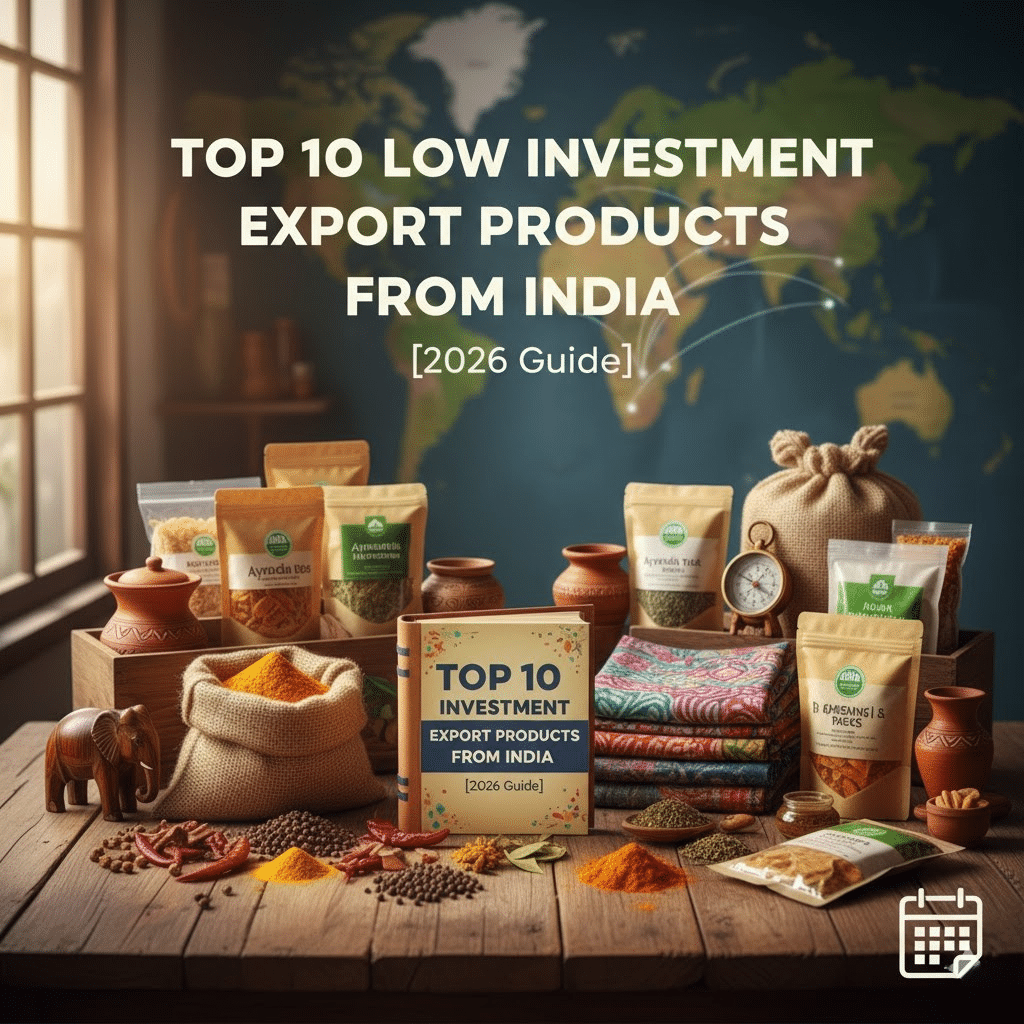
Low investment export products are becoming one of the fastest-growing opportunities for Indian entrepreneurs in 2026. With government support, digital trade platforms, and affordable logistics, even small businesses can now enter the global market with limited capital.
In this guide, we’ll explore the top 10 low investment export products from India, understand why they’re in demand, and see how you can start an export business efficiently.
Why This Is the Right Time to Enter Exports
-
Rising global demand for Indian goods such as spices, handicrafts, and eco-friendly products.
-
Government assistance through organizations like FIEO and DGFT.
-
Simplified processes for MSMEs with digital documentation, shipping partners, and online marketplaces.
How to Choose the Right Product
When evaluating export ideas, focus on items that are:
-
Lightweight and easy to transport
-
Non-perishable or long-lasting
-
High in demand overseas
-
Simple to source locally
-
Profitable even on a small scale
Top 10 Low Investment Export Products from India
1. Handmade Jewelry
Indian artisans create unique, affordable jewelry that sells well in global markets such as the U.S. and Europe.
Approx. Setup: ₹30,000–₹1 Lakh
Tip: Offer niche collections—oxidized silver or tribal themes.
2. Organic Spices
Turmeric, cardamom, and chili powder are Indian staples with growing global demand.
Approx. Setup: ₹50,000–₹2 Lakh
Tip: Register with Spices Board India for authenticity and export certification.
3. Natural Sweeteners (Jaggery, Cane Sugar)
Health-conscious consumers are switching to unrefined sweeteners.
Approx. Setup: ₹40,000–₹1.5 Lakh
Markets: Middle East and Southeast Asia.
4. Incense & Fragrance Products
India’s agarbatti exports are steadily growing due to religious and wellness trends abroad.
Approx. Setup: ₹25,000–₹1 Lakh
Tip: Maintain consistent fragrance quality for repeat orders.
5. Eco-Friendly Bags
Jute and cotton bags fit perfectly with the global sustainability trend.
Approx. Setup: ₹60,000–₹2 Lakh
Tip: Use recyclable packaging and market under “plastic-free” branding.
6. Herbal & Ayurvedic Cosmetics
Herbal soaps, oils, and skincare products are becoming mainstream globally.
Approx. Setup: ₹75,000–₹2 Lakh
Tip: Obtain necessary licenses from the Ministry of AYUSH.
7. Wooden Handicrafts
Hand-carved décor from Rajasthan and Gujarat attracts steady overseas demand.
Approx. Setup: ₹1 Lakh–₹3 Lakh
Tip: Use certified wood and proper packaging to avoid customs issues.
8. Pickles & Ready-to-Eat Foods
Indian condiments are now stocked by major international stores.
Approx. Setup: ₹50,000–₹1.5 Lakh
Tip: Get FSSAI approval before exporting.
9. Imitation Jewelry
Affordable, trendy accessories always find buyers in Africa and Asia.
Approx. Setup: ₹40,000–₹1 Lakh
Tip: Keep seasonal catalogs to match fashion trends.
10. Stationery & Paper Items
Eco-friendly notebooks and handmade paper gifts have growing demand in Europe and Japan.
Approx. Setup: ₹30,000–₹1 Lakh
Tip: Partner with local artisans or NGOs for sustainable production.
Steps to Launch Your Export Journey
-
Apply for Import-Export Code (IEC) via DGFT portal.
-
Register on MSME portal (Udyam) for small-business benefits.
-
List products on verified B2B sites such as Alibaba and IndiaMART Global.
-
Find buyers through LinkedIn, trade fairs, or export associations.
-
Collaborate with CHA/logistics partners for customs and freight.
💡 For hands-on training and mentorship, explore the Export Business Course by CSB. It helps entrepreneurs launch their first export within 12 months.
Smart Tips to Minimize Startup Costs
-
Start small; ship sample quantities first.
-
Use digital channels to connect directly with buyers.
-
Avoid overstocking inventory early.
-
Share warehousing or packaging space with other exporters.
Common Errors to Avoid
-
Skipping quality checks or product certifications.
-
Not verifying buyer authenticity.
-
Misjudging freight and insurance expenses.
-
Weak packaging that leads to damage.
Conclusion
Starting with low investment export products is one of the smartest ways to enter international trade without heavy funding. From eco-friendly bags to herbal cosmetics, these export ideas can bring consistent profits if you choose the right niche and market.
To learn practical steps — from export documentation to finding buyers — explore the Export Business Program by Catalyst School of Business (CSB).
👉 Visit csbworld.com to get started.
FAQs
1. How much capital do I need to start exporting from India?
Usually between ₹50,000 and ₹2 Lakh, depending on product type.
2. Which Indian products are easiest to export?
Spices, handicrafts, and handmade accessories are beginner-friendly.
3. Do I need a company to export goods?
No. You can begin as a sole proprietor with an IEC registration.
4. How can I find international buyers?
Use platforms like Alibaba, Global Sources, and trade networks like FIEO.


